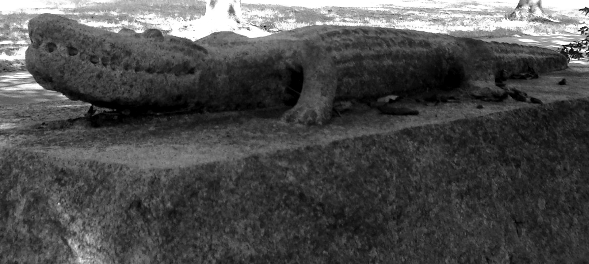If Alligator Joe Campbell really had rounded up "worthless dogs and stray cats" to feed the big, bull gator he rode, few would care if Joe himself wound up in the gator's mouth.
However, although Joe had ridden with Buffalo Bill's Wild West Show, that roundup tale was false.
 |
| Alligator Joe Campbell |
Due to the drainage of the Everglades and other state development, 2.5 million alligators were reportedly killed in the 1880s. Commercial hunters and gun-happy tourists helped decrease the population. There seemed to be no better fun than killing gators while cruising on a steamboat.
Although Campbell also hunted alligators, because he feared their extinction he merged with Jacksonville's ostrich farm, the best in the country. By adding his gator collection to the lanky menagerie, he could study and breed both species.
In 1912, when 200 ostriches strode into their new billet at Phoenix Park, Alligator Joe and his patient pod of gators were already awaiting the bubble-bottomed birds. This lively tourist destination, Florida's original theme park, percolated east of Jacksonville at Talleyrand Avenue, near Evergreen Cemetery and the river.
Ostrich racing was a great sport of the era as contemporary ads and postcards indicate. So, to prevent hurt feelings and jealousy, Campbell likewise trained his gators to race and to carry riders. The alligators' education extended to climbing and to waltzing. While the reptiles and ostriches were not competitive, they spent little time together, promoting ostrich longevity.In 1907, the Dixieland Park exposition and resort opened at the ferry landing in South Jacksonville, where Alligator Joe, some ostriches and alligators, together with electric fountains, burros, bands and theater productions, were major attractions. The reptiles climbed ladders, slid down chutes and carted children on their broad, rough backs. Campbell was also becoming famous in the movies and newsreels for his alligator shenanigans and study of the creatures.
In 1916, the Ostrich Farm and Alligator Farm, in some queer arc, shifted across the river to South Jacksonville on the site of the Aetna Insurance building, originally Prudential Insurance. Campbell and his wife, Sadie, lived on a houseboat near the southern end of the future Main Street Bridge.
Alligator Joe and Sadie continued farming gators in what they called the swamp. As accomplished as Joe, Sadie could mimic the alligator's wild, guttural sound, sometimes a hunting ploy, which lured gators to the river's surface. Often, she accompanied him on tracking expeditions, during which she was also able to nab some floating snakes by looping their so-called necks.
While Campbell wrestled the reptiles and delivered lectures, Sadie managed the store at the Alligator Farm, displaying all possible contrivances from alligator parts, including ashtrays and purse latches (made from the smaller heads), etc. In addition to meat and hides, every part was utilized, creating products from alligator oil to claw purses, from embryos for study to egg shells for souvenirs. In addition, filling orders from across the country, together with instructions for care, the Campbells shipped thousands of baby gators in light, cypress boxes filled with Spanish moss.
They continued to keep some ostriches, and Sadie remembered a surrey race between an ostrich and a horse. She declared, in the short run, an ostrich could always beat a horse, but this ostrich, frightened by a balloon, sat down, giving the horse the advantage.
In later years, Campbell wrote a pamphlet about alligators, which included explanations of his life and work. His early gator farming was in Palm Beach, Arkansas and California. By the time he developed his Jacksonville enterprise, hoping to discourage their cannibalistic tendencies, he separated his alligators by size into pens of 200 head, numbering in the thousands.
When not hibernating, his reptiles ate a total of between five and six tons of fish a week. Old Oklawaha, which according to Joe's own pamphlet reached the thoroughly impossible age of more than 800 years, was his oldest alligator. His type ate a hundred pounds of fish each feeding.
Sadie recalled the only dangerous accident at the farm was when her pet otter escaped and bit her. Of course, she had been bitten by snakes and nipped by gators several times. Then, there was the terrible incident when a guide lost his arm while sticking his head in a gator's mouth and sightseers pulled him free.
Alligator Joe died in 1926 at age 53. He is buried at Evergreen Cemetery with guess what marking his grave?
Hubert Ian Campbell
Born in Berhampur, India
June 10, 1872
Died in Jacksonville, Fla.
March 10, 1926
Beloved by All




The alligator riding was risky, to say the least. But it also puts me in mind of an old song you may remember:
ReplyDeleteShe sailed away, on a bright and sunny day,
On the back of a crocodile.
"You see," said she,"he's as tame as he can be.
I'll float him down the Nile."
The croc winked his eye, as she waved them all goodbye,
Wearing a happy grin.
At the end of the ride, the lady was inside,
And the smile was on the crocodile.
If you're in for some amusing reading, you might try Alligators in B-Flat, by Jeff Klinkenberg.